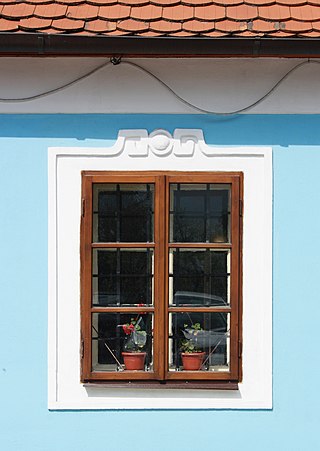Top Qs
Timeline
Chat
Perspective
Chambranle
From Wikipedia, the free encyclopedia
Remove ads
In architecture and joinery, the chambranle is the border, frame, or ornament, made of stone or wood, that is a component of the three sides round chamber doors, large windows, and chimneys.

When a chambranle is plain and without mouldings, it is called a band, case, or frame. The chambranle consists of three parts; the two sides, called montants, or ports, and the top, called the traverse or supercilium. The chambranle of an ordinary door is frequently called a doorcase; of a window, window frame; and of a chimney, manteltree.
Remove ads
History
Look up antepagmenta in Wiktionary, the free dictionary.
In ancient architecture, antepagmenta were garnishings in posts or doors, wrought in stone or timber, or lintels of a window. The word comes from Latin and has been borrowed in English to be used for the entire chambranle, i.e. the door case, or window frame.
See also
References
Wikimedia Commons has media related to Chambranles.
 This article incorporates text from a publication now in the public domain: Chambers, Ephraim, ed. (1728). "Chambranle". Cyclopædia, or an Universal Dictionary of Arts and Sciences. Vol. 1 (1st ed.). James and John Knapton, et al. p. 190.
This article incorporates text from a publication now in the public domain: Chambers, Ephraim, ed. (1728). "Chambranle". Cyclopædia, or an Universal Dictionary of Arts and Sciences. Vol. 1 (1st ed.). James and John Knapton, et al. p. 190.
 This article incorporates text from a publication now in the public domain: Chambers, Ephraim, ed. (1728). "Antepagmenta". Cyclopædia, or an Universal Dictionary of Arts and Sciences. Vol. 1 (1st ed.). James and John Knapton, et al. p. 106.
This article incorporates text from a publication now in the public domain: Chambers, Ephraim, ed. (1728). "Antepagmenta". Cyclopædia, or an Universal Dictionary of Arts and Sciences. Vol. 1 (1st ed.). James and John Knapton, et al. p. 106.
- ANTEPAGMENTA[usurped], Ancient Library, p. 98
External links
Wikiwand - on
Seamless Wikipedia browsing. On steroids.
Remove ads
